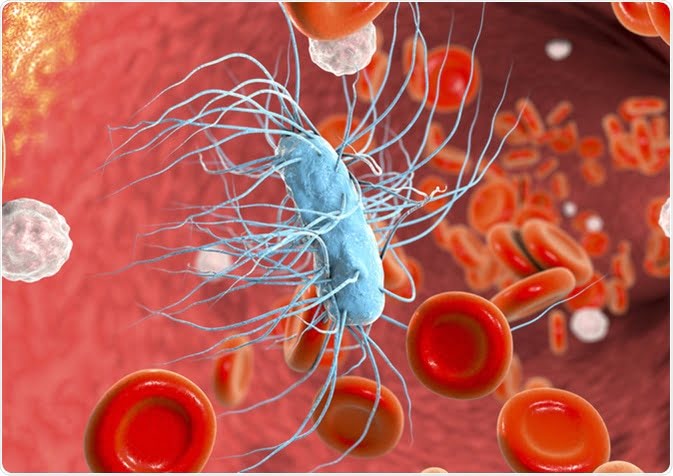This is a potentially life – threatening complication of an infection. This condition is happening when chemicals released into the bloodstream to fight the infection are triggering inflammatory responses throughout the body. This inflammation can trigger a cascade of changes which can damage many organ systems which is causing them to fail. If sepsis progresses to septic shock, then the blood pressure drops dramatically and this can lead to death. Every single person can develop sepsis but it is most common and dangerous in people who have weakened immune system or older adults. The early treatment of sepsis which is usually with large amounts of intravenous fluids and antibiotics can improve the chances for survival. It is found that sepsis kills more than 258,000 Americans per year [1].
Sepsis symptoms, causes and risk factors
Symptoms: Sepsis is 3 – stage syndrome. It starts with sepsis and progress through severe sepsis to septic shock. It is very important to treat sepsis during its early stage before it becomes more dangerous.
- Sepsis: Those people who are diagnosed with sepsis, must exhibit at least 2 of the following symptoms, plus he or she has confirmed or probable infection [2,3]:
- Respiratory rate higher than 20 breaths a minute
- Heart rate higher than 90 beats a minute
- Body temperature above 38.3 C (101F) or 36 C (96.8 F)
- Severe sepsis: If you exhibit at least one of the following signs and symptoms which can indicate that an organ can be failing, then you have severe sepsis.
- Abdominal pain
- Abnormal heart pumping function
- Difficulty breathing
- Decrease in platelet count
- Abrupt change in mental status
- Significantly decreased urine output
- Septic shock: Those people who are diagnosed with septic shock have the signs and symptoms of severe sepsis but also they have extremely low blood pressure which does not adequately respond to fluid replacement. [4]
In the most cases, sepsis happens in people who are hospitalized. Those people who are in intensive care unit are especially vulnerable to developing infections which could lead to sepsis [5]. If you develop some of the mentioned signs and symptoms of sepsis after surgery, hospitalization or infection or if you get an infection, then you should seek medical care immediately.
Sepsis symptoms, causes and risk factors
Causes: Any type of infection, fungal, bacterial or viral can lead to sepsis. The most common infections that cause sepsis are next:
- Bloodstream infections (bacteremia)
- Kidney infection
- Abdominal infection
- Pneumonia
In United States of America, the number of people who are affected by sepsis is increasing. This cause of the increase can include some of the following:
- Weakened immune system: It is known fact that most Americans live with weakened immune system, caused by transplant drugs, cancer treatments or HIV. [6]
- Drug – resistant bacteria: There are many types of bacteria which can resist the effects of antibiotics that once killed them. It is known that in many cases the antibiotic – resistant bacteria are the root cause of the infections that can trigger sepsis.
- Aging population: It is known fact that Americans live longer and this is swelling the ranks of highest risk age group, it means those people who are older than 65.
Risk factors: Here are some factors which can increase your risk of sepsis:
- You have invasive devices, such as breathing tubes or intravenous catheters
- You have wounds or injuries, such as burns
- You are already very sick, often in a hospital’s intensive care unit [5]
- You have a compromised immune system [6]
- You are very young or very old
Complications: This condition ranges from less to more severe. As this condition worsens, the blood flow to the vital organs (such as kidneys, brain and heart) becomes impaired. It is known that sepsis can cause blood clots to form in your organs and in your toes, fingers, legs and arms which are leading to varying degree or organ failure and tissue death (that is known as gangrene). In the most cases, people recover from mild sepsis but the mortality rate for septic shock is nearly 50%. Also if you have an episode of severe sepsis, then it can put you at higher risk for future infections.
References:
[1] Infection Control Today (ICT). Survey reveals majority of Americans have never heard of sepsis. 2012. Retrieved from www.infectioncontroltoday.com/sepsis/survey-reveals-majority-americans-have-never-heard-sepsis
[2] National Institute of General Medical Sciences (NIH). Sepsis. Retrieved from www.nigms.nih.gov/education/pages/factsheet_sepsis.aspx
[3] Berg D, Gerlach H. Recent advances in understanding and managing sepsis. F1000 Research. 2018;7:F1000 Faculty Rev-1570.
[4] Polat G, Ugan RA, Cadirci E, Halici Z. Sepsis and septic shock: Current treatment strategies and new approaches. The Eurasian Journal of Medicine. 2017;49(1):53-8.
[5] Sakr Y, Jaschinski U, Wittebole X, et al. Sepsis in intensive care unit patients: Worldwide data from the intensive care over nations audit. Open Forum Infectious Diseases. 2018;5(12):ofy313.
[6] Delano MJ, Ward PA. The immune system’s role in sepsis progression, resolution and long-term outcome. Immunological Reviews. 2016;274(1):330–53.





